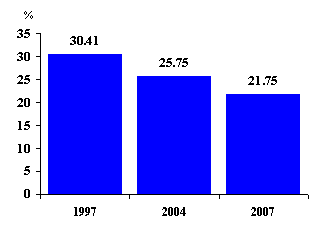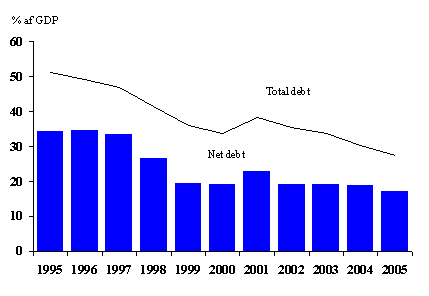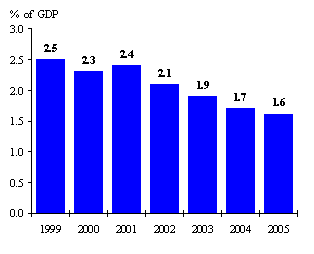News release no. 19/2004. Fiscal budget proposal 2005.
The 2005 fiscal budget proposal is based on the policy of continued stability in the economy in spite of the increase in power project construction activity. This is the result of the restraint in fiscal policy pursued by the Government in the past which will be continued over the next several years. This policy is not only an important precondition for economic stability but also for the Government’s determination to reduce taxes as promised in its Policy Statement issued at the time the Government was formed. The fiscal Medium Term Programme for the next four years is also presented as a part of the fiscal budget proposal, this being the second time that such a Programme is presented. Such a medium-term view of fiscal finances is important in light of the substantial construction projects presently in progress that demand a responsible and resilient economic policy as well as stability in government finances.
A rising revenue surplus reflects fiscal restraint. The 2005 fiscal budget proposal is presented with a revenue surplus of 11.2 billion krónur, equivalent to 1.2 per cent of GDP. This implies that the fiscal balance is significantly strengthened from the estimated result for this year and sharply stronger than in 2003. The improvement in fiscal finances is attributable to expanding economic activity along with expenditure restraint where expenditure has been cut by 3 billion from its baseline estimate. The financial balance is estimated at 4 billion krónur and does not strengthen as much as the revenue balance, since large government bond issues will mature next year along with accrued interest. This will increase the cash outflow although such interest has already been expensed in earlier years.
Treasury finances
|
Budget |
||||
|
Accounts |
Budget |
Estimate |
proposal |
|
|
Billion krónur |
2003 |
2004 |
2004 |
2005 |
|
Revenue........................................... |
273.9 |
282.0 |
290.2 |
305.8 |
|
Expenditure...................................... |
280.0 |
275.3 |
282.4 |
294.6 |
|
Revenue balance...…….................. |
-6.1 |
6.7 |
7.8 |
11.2 |
|
Financial balance...........…………. |
15.3 |
14.0 |
16.9 |
4.0 |
The underlying Treasury balance is further strengthened. The table below shows the finances of the Treasury after adjustment for irregular revenue and expenditure. Irregular revenues include profits from asset sales and irregular expenditures include expensed pension fund commitments and tax claims written off. The adjustment of the Treasury balance for these items show the impact of the Treasury’s normal operations and the effect of the business cycle upon fiscal finances is demonstrated more clearly. By this measure, the Treasury’s revenue balance is strengthened by more than 20 billion krónur from 2003 which shows how fiscal policy is being applied during the period of power project construction.
Revenue balance, excluding irregular items
|
Billion krónur |
Accounts 2003 |
Budget 2004 |
Estimate 2004 |
Proposal 2005 |
|
Revenue balance …….......... |
-6.1 |
6.7 |
7.8 |
11.2 |
|
Irregular expenditure.............. |
14.4 |
8.7 |
8.7 |
8.8 |
|
Irregular revenue... ................. |
9.9 |
0.1 |
0.1 |
0.1 |
|
Rev. bal. excl. irreg. items.... |
-1.6 |
15.3 |
16.4 |
19.9 |
Four-year Medium Term Programme presented for the second time. The Government’s fiscal policy is presented in the fiscal budget for the four-year period 2005-2008. The objective incorporated into the Programme is to ensure economic stability in spite of the sharp expansion of power project construction activity and the recent offer of more extensive housing mortgage credits. A tight fiscal policy will be applied to counter expansion in the economy and play a key role in overall economic policy over the medium term. The main objectives of fiscal policy are as follows:
- A tight fiscal policy will be pursued. The annual growth in public consumption should not exceed 2 per cent in real terms. Central government wage costs should not increase in excess of wage costs in the competitive sectors of the economy. Transfer payments should not increase by more than 2½ per cent a year in real terms.
- Central government investment will be cut by 2 billion krónur in 2005 and another 2 billion in 2006. Investment will be increased again by 2 billion in 2007 and a further 2 billion in 2008.
- Major tax cuts will be implemented in 2005-2007 and priority will be given to certain expenditures, in accordance with the Policy Statement of the Government.
Fiscal restraint is a precondition for tax cuts. In light of economic conditions and the timing of power project investments, the intention is to let the main impact of the tax cuts occur in 2007. The personal income tax rate will be lowered by 4 per cent during the current four-year term of office. The net wealth tax will be abolished, both for individuals and companies. The scheduled abolition of the personal income surtax has already been passed into law. The value added tax will be reviewed in the near future by the parties supporting the Government.
The personal income tax rate

The principal underlying economic assumptions for the 2005 budget. Economic growth is forecast at 5 per cent, inflation at 3½ per cent, unemployment at 2¾ per cent and the current account at 11 per cent of GDP. The exchange rate index is assumed to average 125 points.
Total revenue to increase due to expanding economic activity. Total Treasury revenue is estimated at 306 billion krónur in 2005, a 16 billion increase from the estimate for this year. The increase in mostly due to the continued expansion of economic activity, since economic growth is forecast to be quite pronounced. Tax revenue is forecast to increase by more than 6 per cent from the previous year and amount to more than 280 billion krónur. Nonetheless, tax revenue is expected to decline in relation to GDP. No assumptions are made about revenue from asset sales.
Treasury expenditure to remain virtually constant in real terms. Total Treasury expenditure is estimated at 294.6 billion, an increase of 12 billion from the estimate for this year. In real terms, expenditure is expected to remain virtually unchanged from this year’s estimate and decline in relation to GDP.
Education, social welfare, health and social security continue to be priorities. In spite of increased restraint for total expenditure, the appropriation for a number of priority tasks are significantly increased. The largest increases go to education, law enforcement, to the care of disabled persons and to an increase in the number of nursing home spaces. Current transfer payments increase by 1.2 per cent in real terms, mostly for pensions for disabled persons due to an increase in their number but also to the Student Loan Fund because of an increase in the number of students. Development aid is also being increased.
Special measures taken to strengthen fiscal finances. Current expenditure is projected to increase only by a small margin, and investment outlays will decline, both a result of tight fiscal policy. Expenditure is being cut by a total of 3 billion from its baseline estimate. Current operating expenditure is being cut by 800 million, chiefly by placing a 1 per cent cost-efficiency demand upon government agencies as well as the postponement of investments by 2 billion. On the revenue side, a number of user fees will increase in concert with general price increases. The personal income tax rate will be cut by 1 percentage point, from 25.75 per cent to 24.75 per cent, and the personal income surtax will decline from 4 per cent to 2 per cent.
Improving fiscal finances will reduce debt and interest payments. The total financial surplus for the year 1998-2005 is estimated to exceed 68 billion krónur, most of which is being used to prepay future commitments to the Government Employees Pension Fund, to improve the Treasury’s position with the Central Bank and to repay other Treasury debt. Total Treasury debt is thus estimated to decline by a third from 1998 to 2005, or from 41 per cent of GDP in 1998 to 27½ per cent in 2005. Net Treasury debt, i.e. gross debt less funds relent and other claims, is expected to decline from 26½ per cent to about 17 per cent.
Treasury debt

Interest payments have declined significantly. Lower debt means that interest payments are declining. If the decline in debt since 1998 had not taken place, next year’s interest payments would have been 11 billion krónur higher than is estimated in the budget for 2005, based on an unchanged ratio to GDP.
Interest payments

Continued economic stability. The principal aim of the fiscal budget and the Medium Term Programme is to ensure continued economic stability in spite of increased power project construction activity and rising domestic demand, partly because of more liberal housing mortgage credits. The policy of fiscal restraint incorporated into the budget makes it possible to reduce taxes as promised in the Government’s Policy Statement without compromising the main objectives of economic policy to ensure stability. A tight fiscal policy, as described above, is an important prerequisite in this respect.
Information on the fiscal budget and the Ministry’s new economic forecast is to be found on the Ministry’s website, www.ministryoffinance.is/fiscal-budget.
